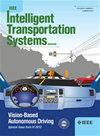A Multimodal Trajectory Prediction Method for Pedestrian Crossing Considering Pedestrian Motion State
IF 5
3区 工程技术
Q1 ENGINEERING, ELECTRICAL & ELECTRONIC
IEEE Intelligent Transportation Systems Magazine
Pub Date : 2023-12-13
DOI:10.1109/mits.2023.3331817
引用次数: 0
Abstract
Predicting pedestrian crossing trajectories has become a primary task in aiding autonomous vehicles to assess risks in pedestrian–vehicle interactions. As agile participants with changeable behavior, pedestrians are often capable of choosing from multiple possible crossing trajectories. Current research lacks the ability to predict multimodal trajectories with interpretability, and it also struggles to capture low-probability trajectories effectively. Addressing this gap, this article proposes a multimodal trajectory prediction model that operates by first estimating potential motion trends to prompt the generation of corresponding trajectories. It encompasses three sequential stages. First, pedestrian motion characteristics are analyzed, and prior knowledge of pedestrian motion states is obtained using the Gaussian mixture clustering method. Second, a long short-term memory model is employed to predict future pedestrian motion states, utilizing the acquired prior knowledge as input. Finally, the predicted motion states are discretized into various potential motion patterns, which are then introduced as prompts to the Spatio-Temporal Graph Transformer model for trajectory prediction. Experimental results on the Euro-PVI and BPI datasets demonstrate that the proposed model achieves cutting-edge performance in predicting pedestrian crossing trajectories. Notably, it significantly enhances the diversity, accuracy, and interpretability of pedestrian crossing trajectory predictions.考虑行人运动状态的行人过街多模式轨迹预测方法
预测行人过街轨迹已成为协助自动驾驶汽车评估行人与车辆互动风险的一项首要任务。作为行为多变的敏捷参与者,行人通常能够从多种可能的过街轨迹中做出选择。目前的研究缺乏预测多模态轨迹的能力,也难以有效捕捉低概率轨迹。针对这一不足,本文提出了一种多模态轨迹预测模型,该模型首先通过估计潜在的运动趋势来生成相应的轨迹。该模型包括三个连续阶段。首先,分析行人的运动特征,并利用高斯混合聚类法获得行人运动状态的先验知识。其次,利用获得的先验知识作为输入,采用长短期记忆模型预测未来行人的运动状态。最后,将预测的运动状态离散化为各种潜在的运动模式,然后将其作为提示引入时空图变换器模型进行轨迹预测。在 Euro-PVI 和 BPI 数据集上的实验结果表明,所提出的模型在预测行人过街轨迹方面达到了最先进的性能。值得注意的是,它大大提高了行人过街轨迹预测的多样性、准确性和可解释性。
本文章由计算机程序翻译,如有差异,请以英文原文为准。
求助全文
约1分钟内获得全文
求助全文
来源期刊

IEEE Intelligent Transportation Systems Magazine
ENGINEERING, ELECTRICAL & ELECTRONIC-TRANSPORTATION SCIENCE & TECHNOLOGY
CiteScore
8.00
自引率
8.30%
发文量
147
期刊介绍:
The IEEE Intelligent Transportation Systems Magazine (ITSM) publishes peer-reviewed articles that provide innovative research ideas and application results, report significant application case studies, and raise awareness of pressing research and application challenges in all areas of intelligent transportation systems. In contrast to the highly academic publication of the IEEE Transactions on Intelligent Transportation Systems, the ITS Magazine focuses on providing needed information to all members of IEEE ITS society, serving as a dissemination vehicle for ITS Society members and the others to learn the state of the art development and progress on ITS research and applications. High quality tutorials, surveys, successful implementations, technology reviews, lessons learned, policy and societal impacts, and ITS educational issues are published as well. The ITS Magazine also serves as an ideal media communication vehicle between the governing body of ITS society and its membership and promotes ITS community development and growth.
 求助内容:
求助内容: 应助结果提醒方式:
应助结果提醒方式:


